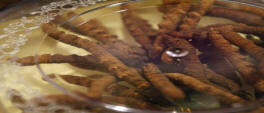Home Is Where You Make IT!
Cordyceps sinesis, or Caterpillar Fungus, is found on the
caterpillar species, Hepialus armoricanus, in certain parts of the
world including some provinces in China, along with other parts of the
higher hills of the Himalayas including Nepal, Tibet, and India.
 Cordyceps sinesis is probably not the first organism someone would
search for in these areas when there are mammals such as black bears and
snow leopards roaming around. The Cordyceps sinesis
species also owns a Tibetan name, yadza gümbu, which translates to
'summer grass, winter worm'. This is because the spores of Cordyceps
sinesis actually infect the caterpillar during the autumn season
and have the carcass completely filled with its mycelium by spring. This
spores of this species are spread by natural forces, like the wind, and land
on soil and plants where the insect feeds, allowing the spores to germinate
within the insect. The deceased caterpillar turns yellowish to brown in
color while the fruiting body continues to grow into summer until it begins
to protrude out of the head of the infected host. The fruiting body contains
more spores to be dispersed by wind back into nature to be fed on again as
the cycle continues.
Cordyceps sinesis is probably not the first organism someone would
search for in these areas when there are mammals such as black bears and
snow leopards roaming around. The Cordyceps sinesis
species also owns a Tibetan name, yadza gümbu, which translates to
'summer grass, winter worm'. This is because the spores of Cordyceps
sinesis actually infect the caterpillar during the autumn season
and have the carcass completely filled with its mycelium by spring. This
spores of this species are spread by natural forces, like the wind, and land
on soil and plants where the insect feeds, allowing the spores to germinate
within the insect. The deceased caterpillar turns yellowish to brown in
color while the fruiting body continues to grow into summer until it begins
to protrude out of the head of the infected host. The fruiting body contains
more spores to be dispersed by wind back into nature to be fed on again as
the cycle continues.
This species is able to be successful in its life cycle because
of the intense conditions the fungi have adapted to. Being able to
thrive 3000 to 5000 meters above sea level is critical for
Cordyceps sinesis which are found in the Himalayan Mountains.
Those that withstand the conditions have powerful.jpg) defenses against
the conditions considering the low oxygen levels leave few life
forms. They also have to withstand freezing temperatures within the deep soil of
the Tibetan plateau and Himalayan regions. Other organisms from Asia
that are used to produce medicines include
Ginseng which is also found near Nepal and
Dendrobium officinal found in South Asia.
defenses against
the conditions considering the low oxygen levels leave few life
forms. They also have to withstand freezing temperatures within the deep soil of
the Tibetan plateau and Himalayan regions. Other organisms from Asia
that are used to produce medicines include
Ginseng which is also found near Nepal and
Dendrobium officinal found in South Asia.
Move on to the learn about the
History of this species!
![]() Classification page!
Classification page!

